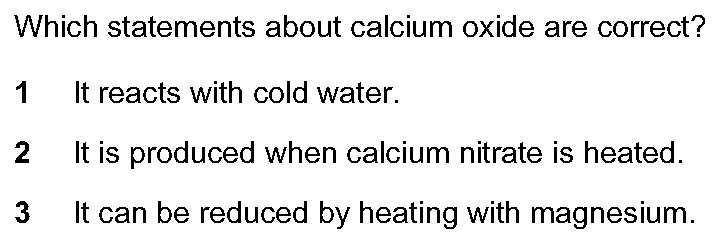
Q36:
AS & A Level Chemistry - 9701 Paper 1 2014 Winter Zone 1
Questions:
36/40

Topic: CH10 - GROUP 2
Solution
Solution is B

PRACTISE
Similar Questions

LEARN
Concepts with Sparky

More Questions from this Topic
Theory
CH10 - GROUP 2
(a) Disodium phosphate, $(\text{Na}^+)_{2}(\text{HPO}_4^{2-})$, reacts with an acid to form monosodium phosphate, $\text{Na}^+(\text{H}_2\text{PO}_4^-...
2024
 Winter
Winter
 Winter
Winter
 2
2
Theory
CH10 - GROUP 2
(a) Table 3.1 shows some properties of two Group 14 elements, C and Sn, in their standard states. The table is incomplete.\begin{center} Table 3.1 \en...
2024
 Winter
Winter
 Winter
Winter
 2
2
Theory
CH10 - GROUP 2
(a) (i) Describe the trend in the solubility of the hydroxides of magnesium, calcium and strontium.Explain your answer...................................
2024
 Summer
Summer
 Summer
Summer
 2
2
Theory
CH10 - GROUP 2
(a) Disodium phosphate, $(Na^+)_2(HPO_4^{2-})$, reacts with an acid to form monosodium phosphate, $Na^+(H_2PO_4^-)$.(i) Identify the ions that are a c...
2024
 Winter
Winter
 Winter
Winter
 2
2
Theory
CH10 - GROUP 2
The Group 2 elements Mg to Ba are all silvery-white reactive metals.(a) (i) Draw a labelled diagram to show the bonding and structure of the Group 2 m...
2023
 Spring
Spring
 Spring
Spring
 2
2
Theory
CH10 - GROUP 2
(a) (i) State the variation in solubilities of group 2 hydroxides........................................................................................
2023
 Winter
Winter
 Winter
Winter
 2
2
Theory
CH10 - GROUP 2
NO and NO_2 react at 25 °C to give N_2O_3 as shown in the equation.NO(g) + NO_2(g) \rightleftharpoons N_2O_3(g) \hspace{5mm} \Delta H = -7.2 \, \text...
2023
 Winter
Winter
 Winter
Winter
 3
3
Theory
CH10 - GROUP 2
(a) (i) State the variation in solubilities of group 2 hydroxides. ......................................................................................
2023
 Winter
Winter
 Winter
Winter
 2
2
Theory
CH10 - GROUP 2
(a) Group 2 nitrates decompose when heated. Describe how the thermal stability of Group 2 nitrates changes with increasing proton number. Explain your...
2023
 Summer
Summer
 Summer
Summer
 2
2
Theory
CH10 - GROUP 2
(a) The most common zinc mineral contains zinc(II) sulfide, ZnS.(i) Complete the electrons in boxes diagram in Fig. 1.1 to show the electronic configu...
2023
 Spring
Spring
 Spring
Spring
 3
3
More Questions from year 2014
MCQ
CH8 - REACTION KINETICS
The Boltzmann distribution for a gas at constant temperature is shown below. If the temperature of the gas is reduced by 10°C the graph changes shape...
2014
 Summer
Summer
 Summer
Summer
 2
2
MCQ
CH2 - ATOMIC STRUCTURE
Which compound has the greatest total number of lone pairs of electrons in the valence shells of all of its atoms?
2014
 Summer
Summer
 Summer
Summer
 2
2
MCQ
CH5 - CHEMICAL ENERGETICS
A reaction pathway diagram is shown. Which enthalpy change could the diagram not apply to?
2014
 Summer
Summer
 Summer
Summer
 3
3
MCQ
CH2 - ATOMIC STRUCTURE
Use of the Data Booklet is relevant to this question.The most common ion-molecule reaction in gas clouds of the Universe is as shown.$$\text{H}_2(g) +...
2014
 Summer
Summer
 Summer
Summer
 2
2
MCQ
CH6 - ELECTROCHEMISTRY
The electrolysis of brine using the diaphragm cell is an important industrial process. What happens at the anode?
2014
 Summer
Summer
 Summer
Summer
 2
2
MCQ
CH5 - CHEMICAL ENERGETICS
Hydrazine, $\text{N}_2\text{H}_4$, is used as a rocket fuel because it reacts with oxygen as shown, producing 'environmentally friendly' gases.$\text{...
2014
 Summer
Summer
 Summer
Summer
 2
2
MCQ
CH4 - STATES OF MATTER
A 10.0 cm^3 bubble of an ideal gas is formed on the sea bed where it is at a pressure of 2020 kPa. Just below the sea surface the pressure is 101 kPa ...
2014
 Summer
Summer
 Summer
Summer
 2
2
MCQ
CH3 - CHEMICAL BONDING
Four substances have the physical properties shown in [Table_1].Which substance is an ionic solid?
2014
 Summer
Summer
 Summer
Summer
 2
2
MCQ
CH5 - CHEMICAL ENERGETICS
The enthalpy change of formation of $\text{Mn(NO}_3)_2(\text{s})$ is $-696\text{ kJ mol}^{-1}$.The enthalpy change of formation of $\text{MnO}_2(\text...
2014
 Summer
Summer
 Summer
Summer
 2
2
MCQ
CH3 - CHEMICAL BONDING
X is an element in Period 2. In which fluoride is the F−X−F angle the largest?
2014
 Summer
Summer
 Summer
Summer
 2
2




 Share
Share




 Previous
Previous




